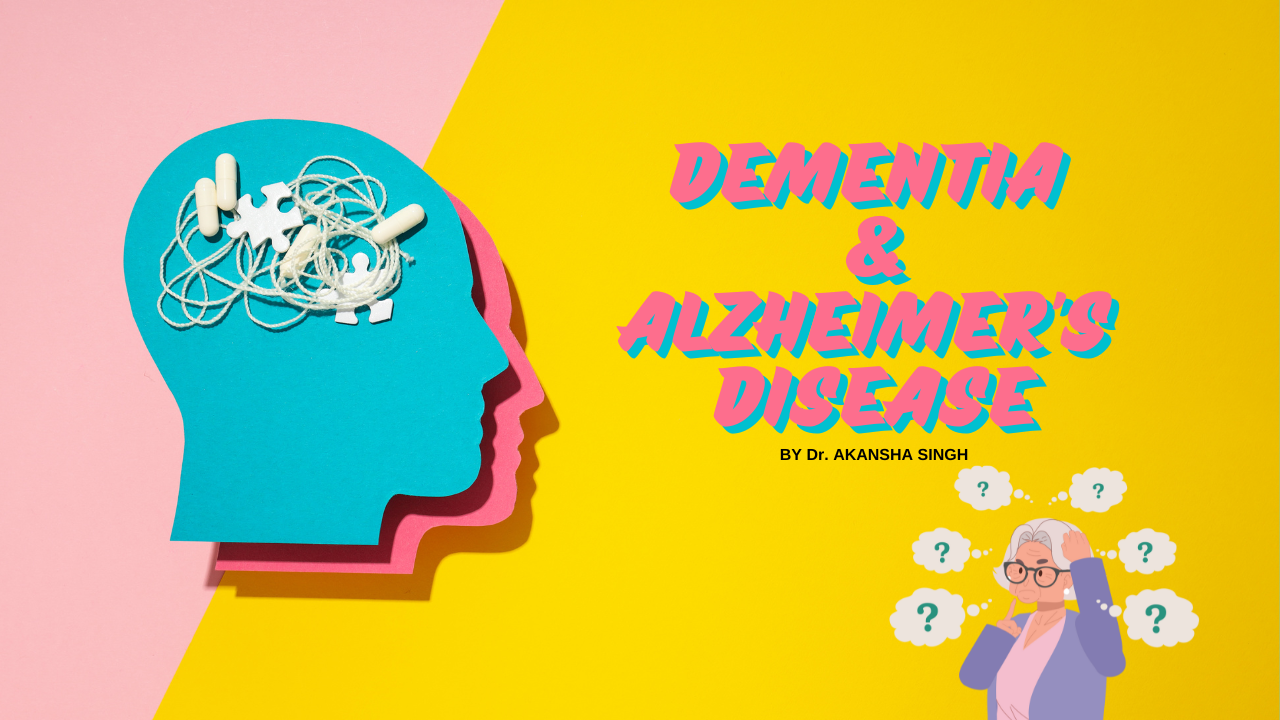DEMENTIA & ALZHEIMERS’S DISEASE
Dementia and Alzheimer’s Disease: Understanding the Basics

Dementia and Alzheimer’s disease, two conditions that often get confused with each other. However, while they are similar, they are distinct in many ways. Let’s start with a basic introduction to these conditions.
What is Alzheimer’s?
Alzheimer’s disease is often mistaken for dementia, but the two are not the same. Dementia is a broad term used to describe various conditions that affect cognitive functions like memory, problem-solving, language, and decision-making. Alzheimer’s, on the other hand, is one of the most common causes of dementia. Both conditions are neurodegenerative, meaning they progressively worsen over time and have no known cure.
Cognitive Function and Symptoms:
Cognitive function refers to our ability to think, reason, and remember. In people with dementia or Alzheimer’s, these abilities start to decline. One of the most common symptoms of both conditions is memory loss, but it’s not just forgetting things—it’s also difficulty with language, solving problems, and making decisions.
For example, a person might struggle to find the right words in a conversation, or they may have trouble following a series of instructions. Over time, these problems can make it hard for individuals to take care of themselves.
Dementia: A Syndrome, Not a Disease:
It’s important to understand that dementia isn’t a single disease like diabetes or hypertension. Instead, it’s a syndrome, meaning it’s a collection of symptoms that result from damage to the brain. This damage can be caused by several different diseases or conditions, including Alzheimer’s. In fact, the word “dementia” comes from the Latin root demens, which means “being out of one’s mind.”
Major Cause of Disability in Older Age:
Dementia is one of the major causes of disability, particularly in older adults. As we age, some decline in cognitive function is natural. However, when this decline happens earlier than expected or progresses rapidly, it could indicate dementia. This condition is also associated with dependence on others, as those affected often lose the ability to care for themselves.
Dementia vs. Alzheimer’s:
Dementia is not one specific disease but a general term that covers a wide range of medical conditions, including Alzheimer’s disease. The disorders grouped under dementia cause changes in the brain that lead to a decline in cognitive abilities. These changes eventually become severe enough to impair daily life and independent functioning.
Impact on Behavior, Emotions, and Relationships:
In addition to affecting memory and thinking, dementia and Alzheimer’s can have a profound impact on behavior, emotions, and personal relationships. People with these conditions may experience mood swings, become easily frustrated or confused, and withdraw from their social lives. This can strain relationships with family and friends, as they struggle to cope with the changes in the person they love.
Understanding Dementia: Definition and Progression

Dementia is a complex condition that involves the progressive deterioration of a person’s intellect, behavior, and personality. This decline occurs slowly over many years, rather than overnight. If it’s not treated in time, the condition continues to worsen. Dementia primarily results from a widespread disease affecting the cerebral hemispheres, particularly the cerebral cortex and hippocampus, which are critical areas of the brain responsible for memory and cognitive function.
According to the World Health Organization (WHO), dementia is a syndrome that can be caused by a number of diseases. Over time, these diseases destroy nerve cells and damage the brain, leading to a significant decline in cognitive function. This deterioration goes beyond what one would expect from normal biological aging.
The progressive impairment caused by dementia affects a person’s intellect, behavior, and personality. These changes are the result of diffuse brain disease, with the most severe impact on the cerebral cortex and hippocampus. Since nerve cells in the brain cannot regenerate, the damage is irreversible.
Definition of Dementia:
Dementia is defined as the progressive deterioration of a person’s intellectual capacity, behavior, and personality. This progressive nature means that it worsens gradually over time, rather than occurring suddenly. The WHO describes dementia as a syndrome caused by multiple diseases, which gradually destroy the nerve cells in the brain, ultimately leading to cognitive decline.
The effects of this nerve cell damage in the brain lead to deterioration in cognitive function, impairing the person’s ability to process thoughts and make decisions. This impairment progresses beyond the normal effects of biological aging and affects daily life significantly.
Epidemiology of Dementia:
Dementia is a growing global health concern, currently affecting around 47 million people worldwide. According to the World Alzheimer’s Report 2015, this number is expected to rise dramatically to 131 million by 2050, with the majority of cases occurring in developing countries.
Dementia can occur at any age, but it is more common in the elderly. Its prevalence increases significantly with age. Approximately 1% of people in their 60s are affected, increasing to 5% in their 70s, and about 15% in their 80s. Rates are slightly higher in women than in men for those aged 65 and older. Currently, over 55 million people worldwide are living with dementia, and nearly 10 million new cases are reported every year. More than 60% of these cases occur in low- and middle-income countries.
Classification of Dementia:
Dementia is classified based on its etiology (causes) and the site of brain damage.
Classification Based on Etiology:
- Degenerative Diseases:
- Pure Dementia:
- Alzheimer’s Disease (~60%)
- Frontotemporal/Pick’s Disease (~5%)
- Dementia Plus Syndromes:
- Dementia with Lewy Bodies (~10%)
- Parkinson’s Disease with Dementia
- Corticobasal Degeneration
- Progressive Supranuclear Palsy
- Huntington’s Disease
- Pure Dementia:
- Cerebrovascular Diseases (20%):
- Multiple Infarct Dementia
- Subcortical Ischemic Vascular Dementia
- Chronic Subdural Hematomas
- Cerebral Amyloid Angiopathy
- Structural Disorders:
- Normal Pressure Hydrocephalus
- Normal Pressure Hydrocephalus
- Infections:
- Syphilis
- HIV
- Nutritional Deficiencies:
- Wernicke-Korsakoff Syndrome (Thiamine Deficiency)
- Vitamin B12 Deficiency
- Metabolic Disorders:
- Hepatic Disease
- Thyroid Disease
- Chronic Inflammatory Conditions:
- Multiple Sclerosis
- Vasculitis
- Trauma:
- Head Injury
- Head Injury
- Neoplasia and Paraneoplasia:
- Frontal Tumor
- Limbic Encephalitis
Classification Based on Site:
- Anterior (Frontal Premotor Cortex):
- Results in behavioral changes and loss of inhibition, often leading to antisocial behavior.
- Example: Frontotemporal Dementia
- Posterior (Parietal and Temporal Lobes):
- Leads to disturbances in cognitive function, such as memory and language issues, without marked changes in behavior.
- Example: Alzheimer’s Disease
- Subcortical:
- Causes individuals to become apathetic, forgetful, and slow, with poor ability to use knowledge.
- Often associated with neurological signs and movement disorders.
- Example: Parkinson’s Disease, AIDS Dementia Complex
- Cortical:
- Affects higher cortical functions, causing difficulties such as dysphasia (language problems), agnosia (inability to recognize objects), and apraxia (difficulty with motor tasks).
- Example: Alzheimer’s Disease
Risk Factors for Dementia:
Several lifestyle and health conditions increase the risk of developing dementia. These include:
- Smoking
- Alcohol Consumption
- Sedentary Lifestyle and Obesity
- High Blood Pressure (Hypertension)
- Hyperlipidemia (High Lipid Levels)
- Hypercholesterolemia (High Cholesterol Levels)
- Depression
- Heart Diseases
- Prior Stroke
Dementia is a complex and progressive condition with significant variations in its causes, manifestations, and impact on individuals. With the expected rise in global cases, understanding its classification, epidemiology, and risk factors is crucial for early diagnosis and management.
Pathology of Dementia

Dementia is characterized by several pathological changes in the brain, including:
- Loss of Neurons: Neurons are the basic working units of the brain, and their loss leads to cognitive decline.
- Neurofibrillary Tangles: These are twisted fibers inside brain cells, primarily composed of the protein tau, which becomes abnormally accumulated and disrupts cell function.
- Senile Plaques: These are deposits of amyloid protein that build up between neurons, disrupting communication.
- Amyloid Angiopathy: This condition involves the deposition of amyloid in the walls of the blood vessels of the brain, leading to vascular dysfunction. These changes are especially prominent in the frontal, temporal, and parietal cortex, as well as in the hippocampus, substantia nigra, and locus coeruleus.
Signs and Symptoms of Dementia:
Dementia presents with a variety of neuropsychiatric symptoms, commonly referred to as Behavioral and Psychological Symptoms of Dementia (BPSD). These symptoms can manifest as:
- Problems with Balance: Difficulty in maintaining stability, often leading to falls.
- Tremor: Uncontrolled shaking or trembling of parts of the body, particularly in the hands.
- Speech and Language Issues: Difficulties in speaking clearly, understanding language, and engaging in conversation.
- Eating/Swallowing Difficulties: In advanced stages, individuals may struggle with the mechanics of eating and swallowing.
- Memory Problems: Short-term memory loss is common, with individuals forgetting recent events or information.
- Wandering or Restlessness: A common behavior in people with dementia, often driven by confusion or anxiety.
- Visual Perception Issues: Problems with depth perception and spatial awareness, making navigation difficult.
Behavioral and Psychological Symptoms of Dementia (BPSD):
Nearly all individuals with dementia will exhibit BPSD at some point during the progression of their condition. These can include:
- Agitation: Restlessness or excessive movement.
- Depression: Persistent sadness or lack of interest in activities.
- Anxiety: Overwhelming worry or fear, often without clear cause.
- Abnormal Motor Behavior: Uncontrolled movements that seem purposeless or excessive.
- Elated Mood: A heightened sense of happiness, often without an apparent reason.
- Irritability: Easily frustrated or angered over minor events.
- Apathy: Lack of interest in social interaction or daily activities.
- Delusions: False beliefs, such as thinking others are stealing from them.
- Hallucinations: Seeing or hearing things that aren’t there.
Other Common Symptoms:
In addition to the cognitive and behavioral symptoms, individuals with dementia often experience:
- Mood Swings: Shifts in mood, particularly irritability.
- Changes in Sleep or Appetite: Individuals may experience significant changes in their sleep patterns and eating habits.
- Restlessness: Difficulty staying still, often leading to pacing or aimless movement.
- Visual Perception Problems: Difficulty recognizing familiar places or navigating through spaces.
Dementia’s pathology is rooted in complex changes in the brain, which manifest as a wide range of cognitive, behavioral, and psychological symptoms. Understanding these key elements is essential for managing and supporting individuals with this condition.
Stages of Dementia

Dementia can be divided into three distinct stages: early stage, middle stage, and late stage. These stages represent the progressive nature of the disease and are outlined below:
Early Stage:
The onset of dementia is gradual, with common symptoms that might initially be mistaken for normal aging. The MMSE scores in this stage are between 20 and 25. Typical symptoms include:
- Memory difficulties: Including trouble finding the right words (anomia) and challenges with planning and organizational skills.
- Losing track of time: Difficulty keeping track of the day, date, or time.
- Becoming lost in familiar places: Affected individuals may forget familiar routes or locations.
- Repeating things: Repetition of questions or statements due to short-term memory loss.
- Personality changes: Subtle changes in behavior, mood, or interests may occur.
- Social withdrawal: Reduced participation in social activities or work due to cognitive decline.
Middle Stage:
In the middle stage, the signs of dementia become more evident and restrictive. The MMSE scores in this stage are between 6 and 17. Symptoms include:
- Severe impairments in solving problems and social judgment: Individuals may make poor decisions or struggle with problem-solving.
- Forgetting recent events and names: This includes forgetting the names of people they know well.
- Getting lost at home: They may become disoriented even in their own home.
- Increased difficulty with communication: Expressing thoughts and following conversations becomes more challenging.
- Needing help with personal care: Tasks such as dressing, bathing, and grooming may require assistance.
- Behavioral changes: Wandering, restlessness, and repeated questioning are common behaviors at this stage.
Late Stage:
In the late stage, dementia leads to near-total dependence on others for care. MMSE scores are below 6. Symptoms include:
- Severe memory disturbances: Individuals may become unaware of time and place and may struggle to recognize close relatives and friends.
- Total dependence for self-care: Tasks such as eating, dressing, and toileting require complete assistance.
- Dietary changes: They may require a pureed diet and thickened liquids to prevent choking or aspiration.
- Difficulty walking: Balance issues and coordination problems lead to difficulty walking, often necessitating support.
- Escalation of behavioral changes: There may be episodes of aggression or other extreme behavioral shifts.
Dementia progresses slowly, but as it advances, the individual’s ability to live independently diminishes. Understanding these stages helps caregivers and medical professionals provide the appropriate level of care and support throughout the progression of the disease.
Diagnosis of Dementia:
Dementia is diagnosed through a combination of cognitive and neuropsychological tests. Some of the primary methods include:
- Mini Mental Scale: A common tool to assess cognitive impairment.
- Rating Anxiety in Dementia: To evaluate the anxiety levels in individuals with dementia.
- The Dementia Quality of Life Instrument: Measures the quality of life in people with dementia.
- Disability Assessment for Dementia: Evaluates the degree of disability caused by dementia.
Imaging and Laboratory Tests:
- CT or MRI Scans: These scans help detect evidence of stroke, bleeding, tumors, or hydrocephalus in the brain.
- PET Scans: PET scans reveal brain activity patterns and can detect amyloid protein deposits, a hallmark of Alzheimer’s disease.
- Laboratory Tests: Basic blood tests can detect issues like Vitamin B12 deficiency or an underactive thyroid, which can affect brain function.
- Spinal Fluid Examination: This test checks for infections, inflammation, or markers of degenerative diseases.
Differential Diagnosis:
Several conditions can cause dementia-like symptoms, which must be identified and treated:
- Vitamin B12 Deficiency
- Thyroid Problems
- Depression
- Medication Side Effects
- Alcohol Abuse
- Infections
- Brain Tumors
- Overmedication
Medical Management:
While most types of dementia cannot be cured, symptoms can be managed with medication:
- Cholinesterase Inhibitors: Drugs such as donepezil (Aricept), rivastigmine (Exelon), and galantamine (Razadyne) increase levels of a neurotransmitter involved in memory and judgment.
- Memantine: This medication regulates glutamate activity, a chemical messenger essential for learning and memory. Memantine is often prescribed alongside cholinesterase inhibitors.
Rehabilitation:
Physiotherapy and occupational therapy are vital components of dementia care:
- Physiotherapy: Helps maintain mobility and manage painful contractures, particularly in end-of-life care.
- Occupational Therapy: Aims to teach coping behaviors and prevent accidents like falls. It also helps manage behavior and prepares patients for the progression of the disease by:
- Modifying the environment: Reducing clutter and noise helps people with dementia focus better.
- Simplifying tasks: Breaking tasks into smaller steps, establishing a routine, and focusing on successes rather than failures.
Treatment and Care:
While there is no cure for dementia, several approaches can help support patients and their caregivers:
- Physical Activity: Staying physically active helps improve overall well-being.
- Social Interactions: Engaging in activities that stimulate the brain and maintain daily function is crucial.
- Medications:
- Cholinesterase inhibitors treat Alzheimer’s disease.
- Memantine is used for severe Alzheimer’s and vascular dementia.
- Medications to control blood pressure and cholesterol help prevent further brain damage in vascular dementia.
- SSRIs can be prescribed for severe depression, although they should not be the first option.
Self-Care for Dementia Patients:
Those diagnosed with dementia can take various steps to manage their symptoms:
- Stay Physically Active
- Eat Healthily
- Quit Smoking and Alcohol: It is recommended to stop both smoking and alcohol consumption.
- Regular Check-Ups: Frequent visits to the doctor help monitor the condition.
- Keep a Diary: Writing down everyday tasks and appointments can help with memory.
- Maintain Hobbies: Continue engaging in activities that you enjoy.
- Stimulate the Mind: Try new ways to keep your brain active.
- Socialize: Spend time with family and friends, and engage in community activities.
- Plan Ahead: As dementia progresses, decision-making becomes harder. Identifying trusted individuals to help with decisions and creating an advance care plan is important.
- Carry Identification: Always bring ID with your address and emergency contacts when going out.
- Seek Help: Reach out to family, friends, and local support groups for assistance.
By incorporating self-care strategies and medical management, individuals with dementia can maintain a better quality of life.
Alzheimer’s Disease: An Overview

Introduction:
Alzheimer’s disease is a degenerative brain disorder of unknown etiology and is the most common form of dementia. This disorder typically begins in late middle age or old age and leads to progressive memory loss, impaired thinking, disorientation, and changes in personality and mood. The disease is characterized by the degeneration of brain neurons, particularly in the cerebral cortex, along with the presence of neurofibrillary tangles and plaques containing beta-amyloid cells.
Key Features:
Alzheimer’s disease often presents with dementia, which refers to a decline in cognitive function that can impair daily life. The condition commonly affects individuals in their later years but can also appear in middle-aged people. The key signs include:
- Progressive memory loss
- Impaired thinking and reasoning
- Deterioration of cognitive functions
- Changes in mood and personality
There is a marked degeneration of neurons in various parts of the brain, especially in the cerebral cortex, leading to cognitive decline and personality changes.
Origin of Alzheimer’s Disease:
Alzheimer’s disease was first described by Dr. Alois Alzheimer, a German physician, in 1906. His patient, Auguste Deter, in her fifties, displayed symptoms of what was then considered mental illness. After her death, an autopsy revealed the presence of dense deposits, now called neuritic plaques, around the nerve cells of her brain. Inside the brain cells, there were twisted strands of fibers known as neurofibrillary tangles. These findings formed the basis of the modern understanding of Alzheimer’s disease, which was named after Dr. Alzheimer.
Meaning of Alzheimer’s Disease:
Alzheimer’s disease is a chronic, irreversible condition that affects brain cells and leads to impairment of intellectual functioning. This disorder gradually destroys the ability to reason, remember, imagine, and learn. It progresses slowly, with cognitive abilities declining over time, ultimately interfering with basic daily activities.
Causes:
The exact cause of Alzheimer’s disease is not known. However, it is believed that several factors contribute to the development of this condition. Research continues to investigate potential genetic, environmental, and lifestyle factors that may play a role in its onset.
Alzheimer’s disease is a complex and challenging condition, with no known cure. Understanding the disease’s origins and characteristics is key to advancing research and finding ways to better manage its effects on individuals and their families.
Alzheimer’s Disease: Understanding the Contributing Factors, Pathophysiology, Symptoms, and Interventions

Alzheimer’s disease is a complex and progressive neurological disorder that primarily affects older adults. While the precise cause of Alzheimer’s remains elusive, several factors contribute to its development. Below, we discuss the various aspects of the disease, including neurochemical, environmental, genetic, and immunologic factors, along with the risk factors, pathophysiology, and treatment approaches.
Factors Contributing to Alzheimer’s Disease:
- Neurochemical Factors:
- Acetylcholine: A neurotransmitter essential for memory and learning.
- Somatostatin: Plays a role in regulating neurotransmitter release.
- Substance P: Involved in neuroinflammation.
- Norepinephrine: Affects alertness and stress response.
- Environmental Factors:
- Cigarette smoking.
- Certain infections.
- Exposure to metals, industrial toxins, or other harmful substances.
- Cholesterol-lowering drugs (statins).
- Genetic and Immunologic Factors:
- Oxidized LDL receptor 1 and Angiotensin 1-converting enzyme: These genes are related to how brain cells bind with Apolipoprotein E4 (APOE4), which helps in reducing harmful protein buildup (plaques) in the brain.
Risk Factors:
- Down’s syndrome.
- Family history of Alzheimer’s disease.
- Chronic high blood pressure.
- Head injuries.
- Gender: Females are at higher risk.
- Smoking and alcohol consumption.
While there are no definitive causes of Alzheimer’s, these factors are commonly implicated.
Pathophysiology of Alzheimer’s Disease:
Alzheimer’s disease attacks nerves, brain cells, and neurotransmitters. The destruction of these critical components causes clumps of protein to form around brain cells. These clumps, known as plaques and neurofibrillary tangles (or bundles), progressively destroy connections between brain cells, worsening the condition over time.
1.Plaques and Neurofibrillary Tangles:
- Plaques are made up of beta-amyloid protein, which accumulates around brain cells.
- Neurofibrillary tangles consist of tau protein, which builds up inside brain cells.
The presence of these plaques and tangles disrupts communication between brain cells, leading to further degeneration of brain function.
2.Vascular Degeneration: Affects blood flow and nutrient delivery to the brain.
3.Loss of Choline: Reduces the production of acetylcholine, a vital neurotransmitter for memory.
Signs and Symptoms:
Ten Warning Signs of Alzheimer’s Disease:
- Memory loss.
- Difficulty performing familiar tasks.
- Problems with language.
- Disorientation in time and place.
- Poor or decreased judgment.
- Problems with abstract thinking.
- Misplacing things.
- Changes in mood or behavior.
- Changes in personality.
- Loss of initiative.
Other Symptoms:
- Confusion.
- Disturbances in short-term memory.
- Problems with attention and spatial orientation.
- Personality changes.
- Language difficulties.
- Unexplained mood swings.
Diagnostic Tests:
Diagnosis is based on a combination of psychiatric assessments and brain imaging techniques. Common tests include:
- Mental status examination and neuropsychological assessment.
- Laboratory tests.
- Brain imaging: CT scans, MRIs, PET scans, and SPECT.
- CSF (Cerebrospinal Fluid) Examination.
- Electroencephalogram (EEG).
- Electromyogram (EMG).
Pharmacological Interventions

Medications for Alzheimer’s focus on slowing the progression of the disease and managing symptoms. These include:
- Acetylcholinesterase Inhibitors:
- Prevent the breakdown of acetylcholine, improving communication between brain cells.
- Examples: Donepezil (Aricept), Rivastigmine (Exelon), and Galantamine (Razadyne).
- NMDA Receptor Antagonists:
- Block NMDA receptors and inhibit overstimulation by the neurotransmitter glutamate.
- Example: Memantine.
- Antidepressants, Anxiolytics, Antipsychotics, and Anticonvulsants: Used to manage behavioral and psychological symptoms associated with Alzheimer’s.
Psychosocial Interventions:
- Behavioral Approaches:
- Help manage challenging behaviors and improve the quality of life.
- Help manage challenging behaviors and improve the quality of life.
- Emotion-Oriented Approaches:
- Reminiscence therapy.
- Validation therapy.
- Supportive psychotherapy.
- Sensory integration therapy.
- Stimulated presence therapy.
- Cognitive-Oriented Approaches:
- Focus on maintaining cognitive abilities through stimulation and structured activities.
- Focus on maintaining cognitive abilities through stimulation and structured activities.
- Caregiving: Since Alzheimer’s has no cure, caregiving plays a crucial role in managing the disease. Caregivers support patients through the various stages, ensuring their safety and comfort.
Prognosis:
The early stages of Alzheimer’s are difficult to diagnose, and definitive diagnoses are usually made when cognitive impairments affect daily living activities. Over time, patients progress from mild memory loss to severe cognitive disturbances, eventually losing the ability to live independently.
- Life Expectancy:
- The average life expectancy after diagnosis is around seven years, with fewer than 3% of patients surviving more than 14 years.
- Survival is shorter for patients with increased cognitive impairment, a history of falls, or other neurological disturbances.
- Comorbidities:
- Diseases such as heart problems, diabetes, or alcohol abuse can reduce life expectancy.
- Men tend to have a less favorable survival prognosis than women.
- Causes of Death:
- Alzheimer’s is the underlying cause of death in 70% of cases. Pneumonia and dehydration are the most common immediate causes, while cancer is less frequent among Alzheimer’s patients compared to the general population.








